Plastic Limit Pressure and Stress Intensity Factor for Cracked Elbow Containing Axial Semi-Elliptical Part-Through Crack
Abstract
:1. Introduction
2. Problem Description
3. Methodology
4. Results
5. FAD Procedure
6. Discussion
7. Conclusions
Author Contributions
Funding
Institutional Review Board Statement
Informed Consent Statement
Data Availability Statement
Conflicts of Interest
Nomenclature
| P | Design pressure |
| PL | Plastic limit pressure |
| a | Crack depth |
| c | Half semi-elliptical crack |
| W | Remaining ligament |
| E | Young’s modulus |
| ρ | Material density |
| Rp0.2 | Yield strength |
| Rm | Ultimate strength |
| ν | Poisson’s ratio in elastic range |
| t | Wall thickness |
| KI | Stress intensity factor |
| PLS | Plastic limit pressure of a straight pipe |
| σY | Yield stress |
| Kr | Ratio between stress intensity factor and fracture toughness of the material |
| Lr | Ratio between internal pressure and plastic limit pressure |
| PF | Failure pressure |
References
- Diem, H.; Müller, K.U. Deformation and failure behavior of elbows. In Proceedings of the Eighth Conference on Structural Mechanics in Reactor Technology, F1 7/9, Brussels, Belgium, 19–23 August 1985; pp. 269–274. [Google Scholar]
- Diem, H.; Blind, D.; Katzenmeier, G.; Hunger, H.A. Crack initiation and crack propagation of an elbow under in-plane bending in high temperature water of elevated oxygen content. In United States: American Association for Structural Mechanics in Reactor Technology; NC State University Libraries: Raleigh, NC, USA, 1989. [Google Scholar]
- Liu, H.; Zhou, Z.; Liu, M. A probability model of predicting the sand erosion profile in elbows for gas flow. Wear 2015, 342–343, 377–390. [Google Scholar] [CrossRef]
- Katinić, M.; Kozak, D.; Božić, Ž.; Gelo, I. Plastic limit pressures for cracked tube containing twin collinear axial through-wall cracks. Arch. Appl. Mech. 2019, 89, 805–811. [Google Scholar] [CrossRef]
- Muthanna, B.G.N.; Bouledroua, O.; Meriem-Benziane, M.; Setvati, M.R.; Djukic, M.B. Assessment of corroded API 5L X52 pipe elbow using a modified failure assessment diagram. Int. J. Press. Vessel. Pip. 2021, 190, 104291. [Google Scholar] [CrossRef]
- Peng, L.C.; Peng, T.L. Pipe Stress Engineering; ASME Press: New York, NY, USA, 2009; Volume 2. [Google Scholar] [CrossRef]
- Jang, H.W.; Hahm, D.; Jung, J.W.; Hong, J.W. Effective numerical approach to assess low-cycle fatigue behavior of pipe elbows. Nucl. Eng. Technol. 2018, 50, 758–766. [Google Scholar] [CrossRef]
- Kiefner, J.F.; Maxey, W.A.; Eiber, R.J.; Duffy, A.R. Failure Stress Levels of Flaws in Pressurized Cylinders; ASTM Special Technical Publications: West Conshohocken, PA, USA, 1973; pp. 461–481. [Google Scholar] [CrossRef]
- Chell, G.G. Elastic-plastic fracture mechanics. Dev. Fract. Mech. 1979, 1, 67–105. [Google Scholar]
- TPRD/L/2566/N83; Ewing, D.J.F. On the Plastic Collapse of a Thin-Walled Pressurised Pipe with an Axial Crack. CEGB Memorandum: London, UK, 1983.
- SID/REP/0191; Carter, A.J. A Library of Limit Loads for FRACTURE-TWO. Nuclear Electric Report TD: Toronto, ON, Canada, 1992.
- Jun, H.K.; Choi, J.B.; Kim, Y.J.; Park, Y.W. The Plastic Collapse Solutions Based on Finite Element Analyses for Axial Surface Cracks in Pipelines under Internal Pressure; ASME-PUBLICATIONS-PVP: New York, NY, USA, 1998; Volume 373, pp. 523–528. [Google Scholar]
- Kim, Y.J.; Shim, D.J.; Huh, N.S.; Kim, Y.J. Plastic limit pressures for cracked pipes using finite element limit analyses. Int. J. Press. Vessel. Pip. 2002, 79, 321–330. [Google Scholar] [CrossRef]
- Kim, Y.J.; Shim, D.J.; Nikbin, K.; Kim, Y.J.; Hwang, S.S.; Kim, J.S. Finite element based plastic limit loads for cylinders with part-through surface cracks under combined loading. Int. J. Press. Vessel. Pip. 2003, 80, 527–540. [Google Scholar] [CrossRef]
- Staat, M. Local and global collapse pressure of longitudinally flawed pipes and cylindrical vessels. Int. J. Press. Vessel. Pip. 2005, 82, 217–225. [Google Scholar] [CrossRef]
- Kim, Y.J.; Oh, C.S.; Song, T.K. Net-section limit pressure and engineering J estimates for axial part-through surface cracked pipes. In Proceedings of the ASME 2007 Pressure Vessels and Piping Conference, San Antonio, TX, USA, 22–26 July 2008; Volume 6, pp. 25–32. [Google Scholar] [CrossRef]
- Lei, Y. A review of limit load solutions for cylinders with axial cracks and development of new solutions. Int. J. Press. Vessel. Pip. 2008, 85, 825–850. [Google Scholar] [CrossRef]
- Tonković, Z.; Skozrit, I.; Alfirević, I. Influence of flow stress choice on the plastic collapse estimation of axially cracked steam generator tubes. Nucl. Eng. Des. 2008, 238, 1762–1770. [Google Scholar] [CrossRef]
- Wang, Q.; Zhou, W. A new burst pressure model for thin-walled pipe elbows containing metal-loss corrosion defects. Eng. Struct. 2019, 200, 109720. [Google Scholar] [CrossRef]
- Griffiths, J.E. The Effect of Cracks on the Limit Load of Pipe Bends Under In-Plane Bending: Experimental Study. Int. J. Mech. Sci. 1979, 21, 119–130. [Google Scholar] [CrossRef]
- Miller, A.G. Review of Limit Loads of Structures Containing Defects. Int. J. Press. Ves. Pip. 1988, 32, 197–327. [Google Scholar] [CrossRef]
- Zahoor, A. Ductile Fracture Handbook; Novetech Corporation: Rockville, MD, USA; Electric Power Research Institute: Palo Alto, CA, USA, 1989. [Google Scholar]
- Yahiaoui, K.; Moffat, D.G.; Moreton, D.N. Damage assessment of piping elbows loaded by steady internal pressure and dynamic in-plane or out-of-plane bending. In Proceedings of the Eighth International Conference on Pressure Vessel Technology, Montreal, QC, Canada, 21–26 July 1996; Volume 1, pp. 361–375. [Google Scholar]
- Miura, N.; Nakayana, Y. Ductile fracture experiments for through wall cracked elbows at high temperature subjected to in-place bending. ASME PVP 1997, 350, 97–105. [Google Scholar]
- Prabhakaran, K.M.; Bhate, S.R.; Bhasin, V.; Ghosh, A.K. Elastic-Plastic Analysis of an Elbow with Axial Part-through Internal Crack at Crown under In-Plane Bending; PVP 2008-61452; ASME: New York, NY, USA, 2008; Available online: http://www.asme.org/about-asme/terms-of-use (accessed on 9 January 2024).
- Wang, C.; Wang, Y.P.; Li, P.N.; Chen, J.; Sun, X.M. Limit Loads for Cracked Elbows Under In-Plane Bending Moment. In Proceedings of the International Conference on Advanced Technology of Design and Manufacture (ATDM 2010), Beijing, China, 23–25 November 2010. [Google Scholar]
- Chattopadhyay, J.; Nathani, D.K.; Dutta, B.K.; Kushwaha, H.S. Closed-Form Collapse Moment Equations of Elbows under Combined Internal Pressure and In-Plane Bending Moment; ASME: New York, NY, USA, 2000. [Google Scholar]
- Wang, C.; Xuan, F.; Li, P. Collapse loads for cracked piping elbows under internal pressure and in-plane moment. In Proceedings of the 18th International Conference on Structural Mechanics in Reactor Technology (SMiRT 18), Beijing, China, 7–12 August 2005. [Google Scholar]
- Manoj Simha, C.H. Limit load solutions for cracked elbows subjected to internal pressure and in-plane bending. J. Press. Vessel Technol. Trans. ASME 2012, 134, 041201. [Google Scholar] [CrossRef]
- Saravanan, M.; Gandhi, P.; Vishnuvardhan, S.; Raghava, G.; Sahu, M.K.; Gupta, S.K.; Chattopadhyay, J. Fracture Studies on Through-Wall Cracked Straight Pipes and Elbows under Internal Pressure and Bending. Exp. Tech. 2023, 47, 941–957. [Google Scholar] [CrossRef]
- Song, T.K.; Kim, Y.J.; Oh, C.K.; Jin, T.E.; Kim, J.S. Net-section limit moments and approximate J estimates for circumferential cracks at the interface between elbows and pipes. Int. J. Press. Vessel. Pip. 2009, 86, 495–507. [Google Scholar] [CrossRef]
- Hong, S.P.; Kim, J.H.; Kim, Y.J. Limit pressures of 90° elbows with circumferential surface cracks. Eng. Fract. Mech. 2009, 76, 2202–2216. [Google Scholar] [CrossRef]
- Hong, S.P. Effect of Internal Pressure on Plastic Loads of 90° Elbows with Circumferential Cracks under Combined Bending. Ph.D. Dissertation, Korea University, Seoul, Republic of Korea, 2011. [Google Scholar]
- Kang, S.J.; Choi, J.H.; Lee, H.; Cho, D.H.; Choi, J.B.; Kim, M.K. Limit load solutions for elbows with circumferential through-wall crack under the pressure-induced bending restraint effect. Int. J. Press. Vessel. Pip. 2019, 177, 103983. [Google Scholar] [CrossRef]
- Kim, M.; Kim, J.; Kim, M.K.; Choi, J.-B.; Huh, N.-S.; Kim, K. Plastic Limit Pressure Solutions for Elbows With Slant Through-Wall Cracks. J. Press. Vessel Technol. 2020, 142, 051502. [Google Scholar] [CrossRef]
- Kim, J.H.; Kim, M.K.; Choi, Y.R.; Cho, D.H.; Kim, M.K.; Choi, J.B. A study on the effect of non-idealized crack on a 90° elbow by using finite element analysis. In Proceedings of the ASME 2018 Pressure Vessels and Piping Conference, Prague, Czech Republic, 15–20 July 2018; American Society of Mechanical Engineers: New York, NY, USA, 2018; Volume 51685, p. V06BT06A007. [Google Scholar]
- EU Project BE 95-1462; SINTAP, Structural Integrity Assessment Procedure, Final Revision. Brite Euram Programme: Brussels, Belgium, 1999.
- EDF Energy. R6: Assessment of the integrity of structures containing defects. In Revision 4, with Amendments to Amendment 11; EDF Energy: Gloucester, UK, 2015. [Google Scholar]
- Konjatić, P.; Kozak, D.; Gubeljak, N. The influence of the weld width on fracture behavior of the heterogeneous welded joint. Key Eng. Mater. 2012, 488, 367–370. [Google Scholar] [CrossRef]
- Lei, Y. Review of limit load solutions for defective pipe bends. In EDF Energy Report E/REP/BBGB/0060/GEN/09, Revision 0; EDF Energy Nuclear Generation Ltd.: Gloucestershire, UK, 2011. [Google Scholar]
- Lei, Y.; Budden, P.J. Predictions for Defective Pipe Elbows Via the Reference Stress Method. J. Press. Vessel Technol. Trans. ASME 2022, 144, 031303. [Google Scholar] [CrossRef]
- Penner, S.S. Combined Power Plants, Including Combined Cycle Gas Turbine (CCGT) Plants; Horlock, J.H., Ed.; Pergamon Press: Oxford, UK, 1993; 288p. [Google Scholar]
- Damjanović, B.; Turk, D.; Konjatić, P.; Katinić, M. Calculation of critical pipeline geometry in thermal power plants. In Proceedings of the 12th International Natural Gas, Heat and Water Conference, Online Conference, 7–9 June 2021; Raos, P., Ed.; IAEE: Dallas, TX, USA, 2021. [Google Scholar]
- Li, Y.; Wang, Y.; Cai, J.; Ren, C.; Zhang, B.; Zhang, B. Structural Design of Pressure Pipeline Wedge-Shaped Concrete Piers. Teh. Vjesn. 2023, 30, 1373–1378. [Google Scholar]
- EN 10216-2:2020; Seamless Steel Tubes for Pressure Purposes—Technical Delivery Conditions—Part 2: Non-Alloy and Alloy Steel Tubes with Specified Elevated Temperature Properties. European Committee for Standardization: Brussels, Belgium, 2020.
- Ansys Workbench. Available online: https://www.ansys.com/products/ansys-workbench (accessed on 10 January 2024).
- TuringBot Software. Sao Paulo, Brazil. 2023. Available online: https://turingbotsoftware.com/ (accessed on 16 April 2024).
- Konjatić, P.; Katinić, M.; Kozak, D.; Gubeljak, N. Yield Load Solutions for SE (B) Fracture Toughness Specimen with I-Shaped Heterogeneous Weld. Materials 2021, 15, 214. [Google Scholar] [CrossRef]


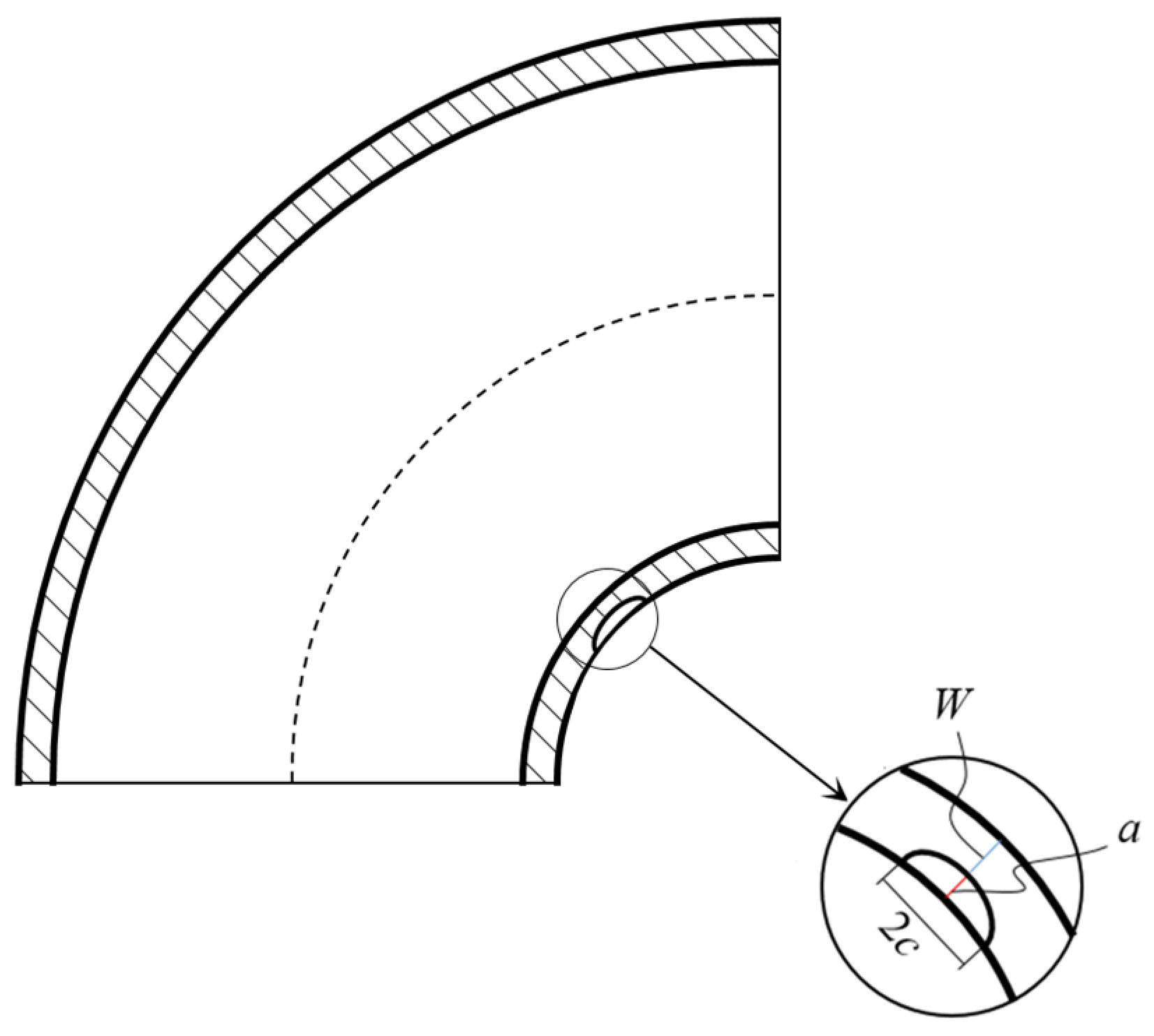

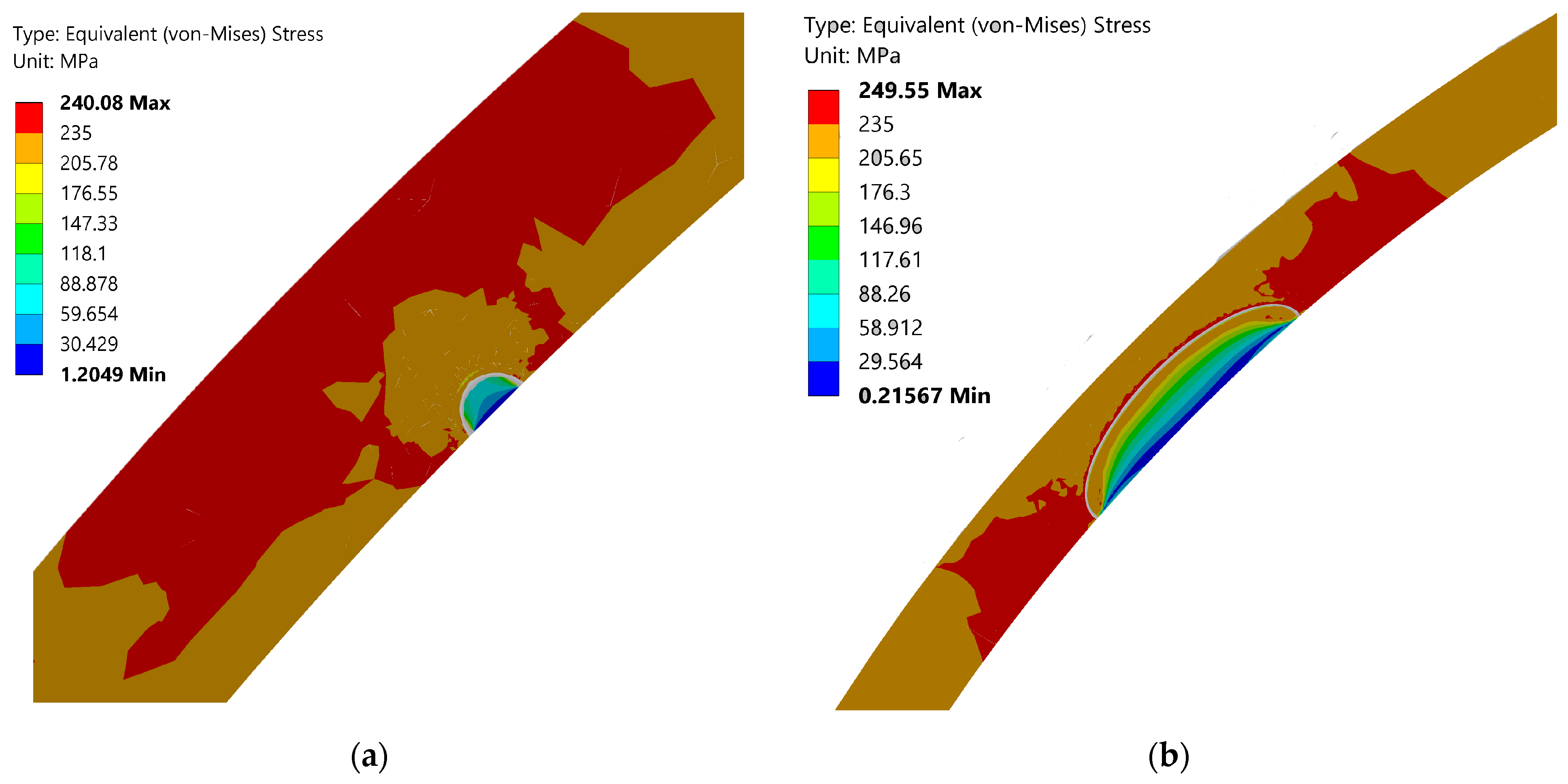
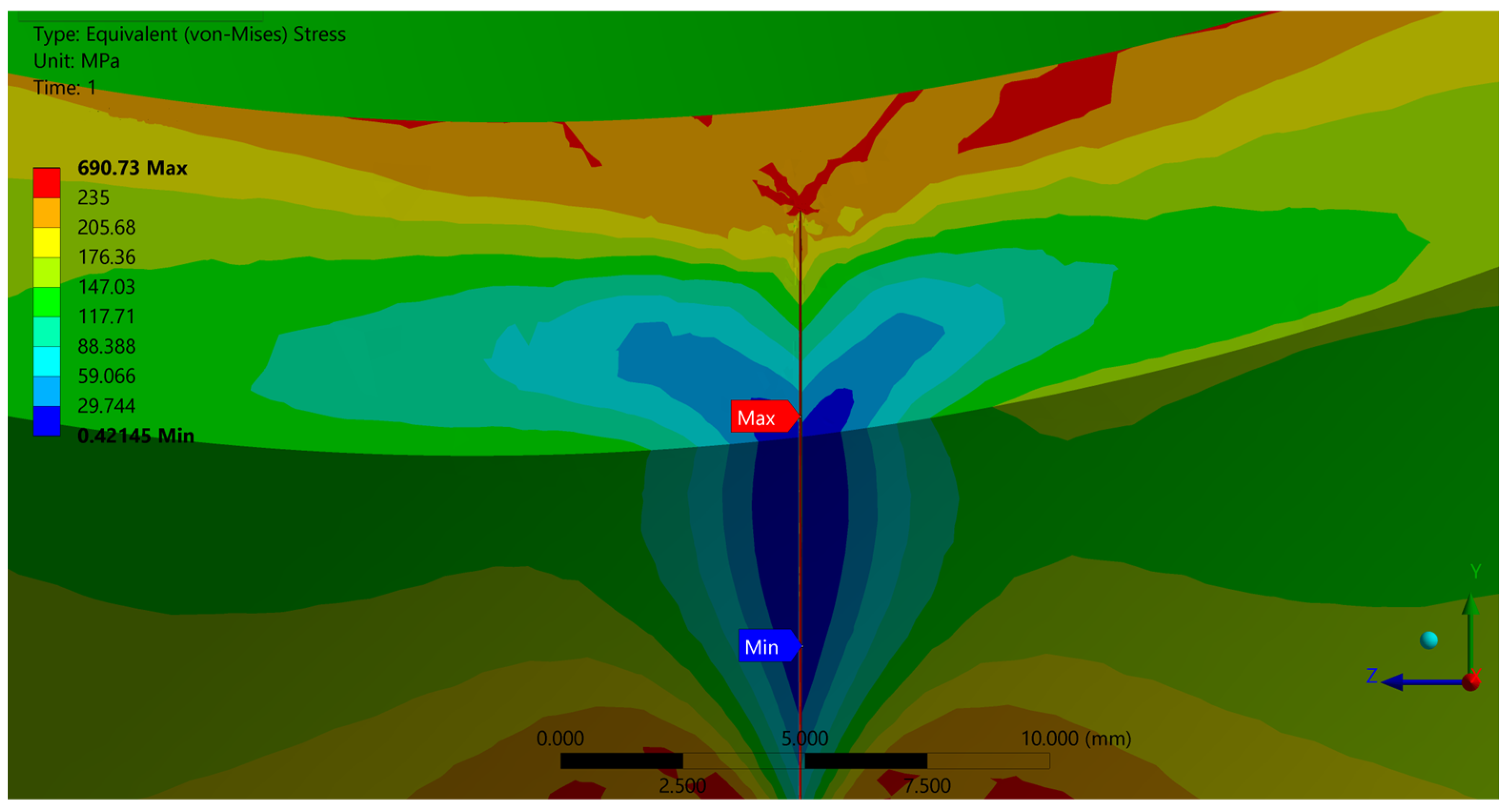

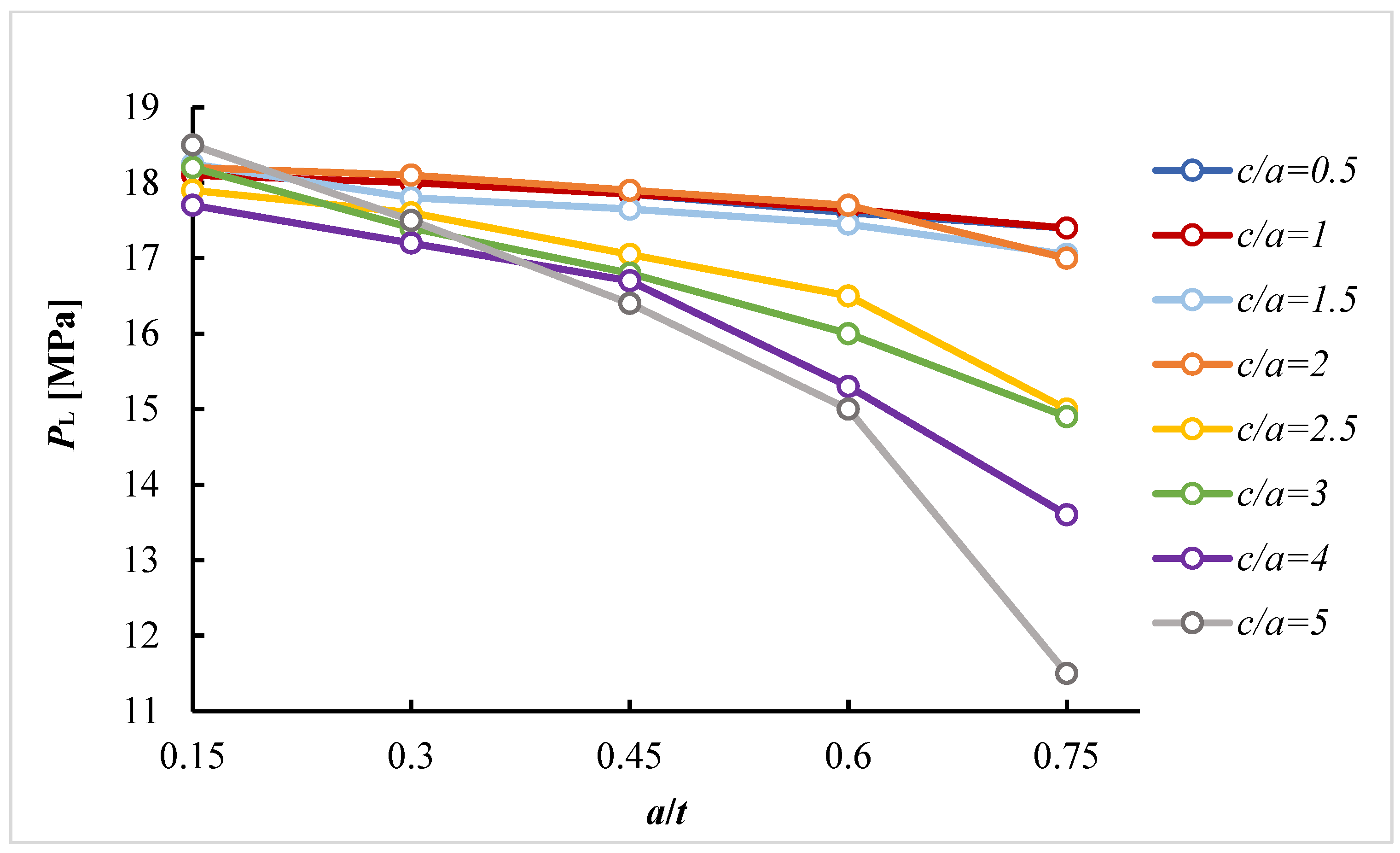

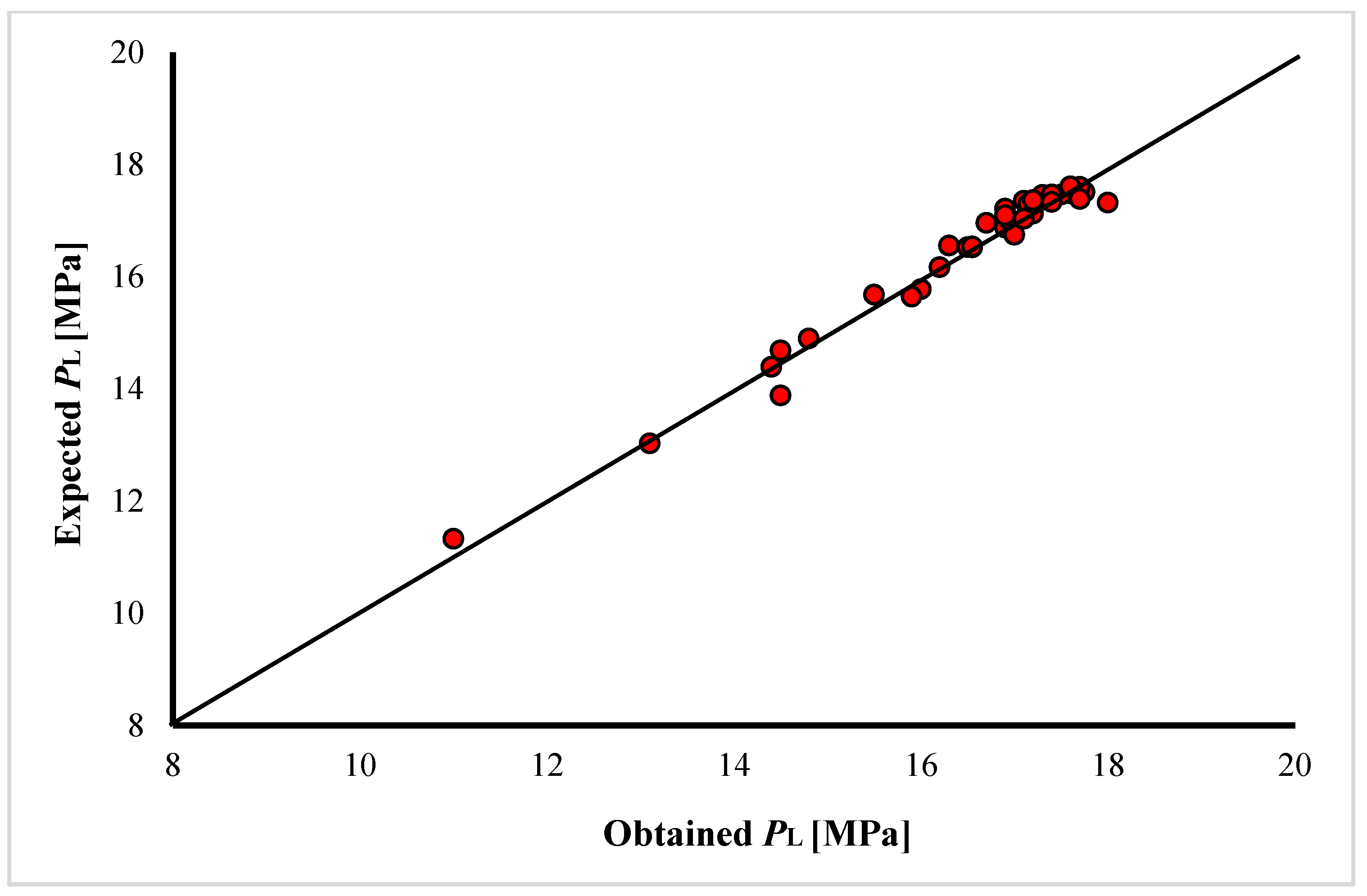
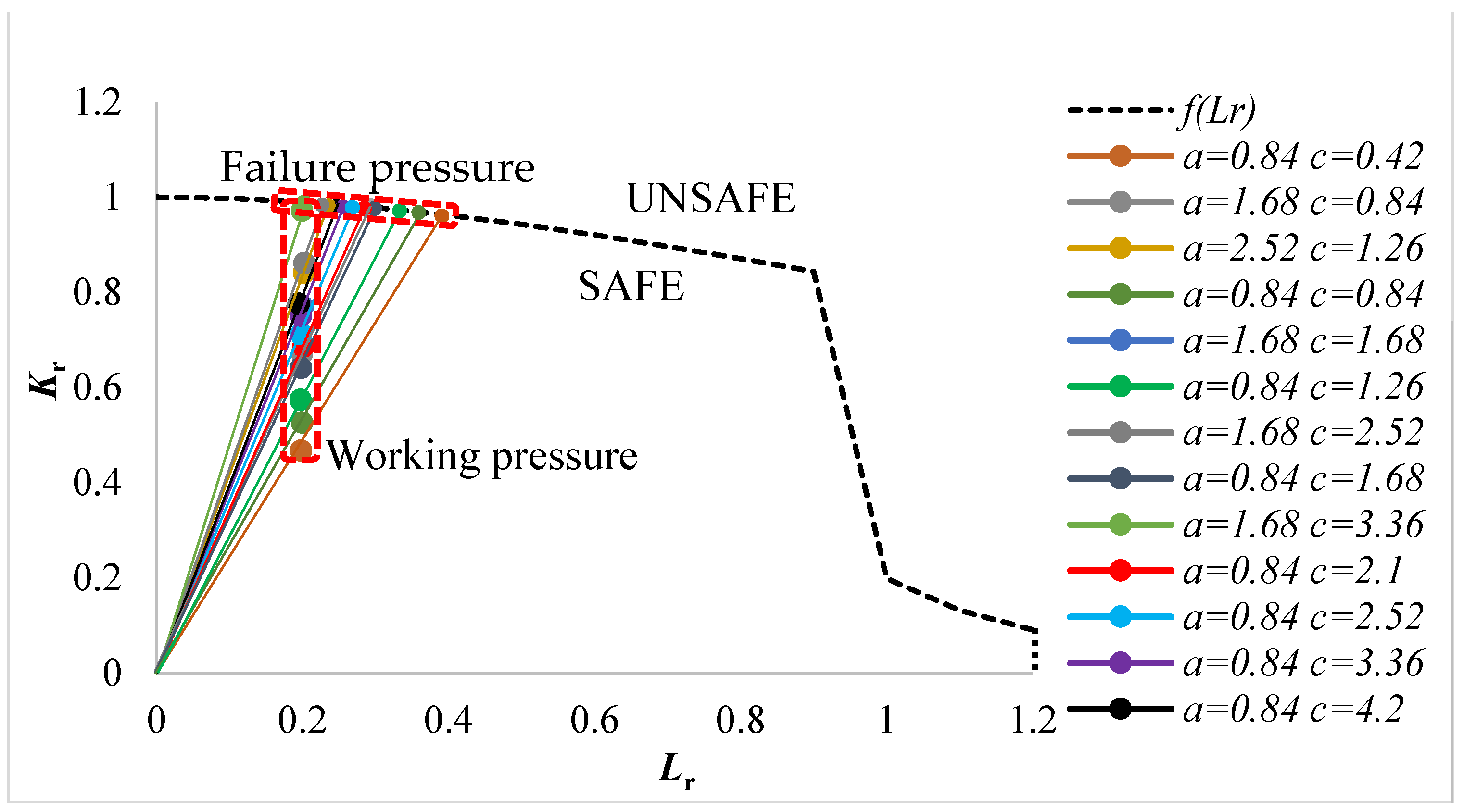
| Material Property | Value |
|---|---|
| Young’s modulus (E): | 200,000 MPa |
| Density (ρ): | 7700 kg/m3 |
| Yield strength (Rp0.2): | 235 MPa |
| Ultimate strength (Rm): | 360 MPa |
| Poisson’s ratio in elastic range (ν): | 0.3 |
| c/a | a (mm) | c (mm) | a/t | KI | PL (MPa) | PLS (MPa) |
|---|---|---|---|---|---|---|
| 0.5 | 0.84 | 0.42 | 0.15 | 49.811 | 17.7 | 19.62 |
| 1.68 | 0.84 | 0.30 | 71.584 | 17.6 | 19.62 | |
| 2.52 | 1.26 | 0.45 | 89.724 | 17.35 | 19.60 | |
| 3.36 | 1.68 | 0.60 | 106.6 | 17.1 | 19.54 | |
| 4.2 | 2.1 | 0.75 | 123.044 | 16.9 | 19.36 | |
| 1 | 0.84 | 0.84 | 0.15 | 56.137 | 17.6 | 19.61 |
| 1.68 | 1.68 | 0.30 | 82.088 | 17.5 | 19.60 | |
| 2.52 | 2.52 | 0.45 | 106.439 | 17.35 | 19.52 | |
| 3.36 | 3.36 | 0.60 | 131.995 | 17.15 | 19.29 | |
| 4.2 | 4.2 | 0.75 | 159.593 | 16.9 | 18.63 | |
| 1.5 | 0.84 | 1.26 | 0.15 | 61.258 | 17.75 | 19.62 |
| 1.68 | 2.52 | 0.30 | 91.864 | 17.3 | 19.57 | |
| 2.52 | 3.78 | 0.45 | 120.197 | 17.15 | 19.39 | |
| 3.36 | 5.04 | 0.60 | 148.292 | 16.95 | 18.91 | |
| 4.2 | 6.3 | 0.75 | 183 | 16.55 | 17.59 | |
| 2 | 0.84 | 1.68 | 0.15 | 68.386 | 17.7 | 19.61 |
| 1.68 | 3.36 | 0.30 | 103.613 | 17.6 | 19.53 | |
| 2.52 | 5.04 | 0.45 | 138.654 | 17.4 | 19.23 | |
| 3.36 | 6.72 | 0.60 | 175.518 | 17.2 | 18.42 | |
| 4.2 | 8.4 | 0.75 | 211.721 | 16.5 | 16.4 | |
| 2.5 | 0.84 | 2.1 | 0.15 | 73.142 | 17.4 | 19.61 |
| 1.68 | 4.2 | 0.30 | 112.172 | 17.1 | 19.47 | |
| 2.52 | 6.3 | 0.45 | 153.451 | 16.55 | 19.02 | |
| 3.36 | 8.4 | 0.60 | 199 | 16 | 17.87 | |
| 4.2 | 10.5 | 0.75 | 245.813 | 14.5 | 15.19 | |
| 3 | 0.84 | 2.52 | 0.15 | 75.898 | 17.7 | 19.60 |
| 1.68 | 5.04 | 0.30 | 117.541 | 16.9 | 19.41 | |
| 2.52 | 7.56 | 0.45 | 164.599 | 16.3 | 18.79 | |
| 3.36 | 10.08 | 0.60 | 218.923 | 15.5 | 17.27 | |
| 4.2 | 12.6 | 0.75 | 277.304 | 14.4 | 14.06 | |
| 4 | 0.84 | 3.36 | 0.15 | 80.051 | 17.2 | 19.58 |
| 1.68 | 6.72 | 0.30 | 127.446 | 16.7 | 19.26 | |
| 2.52 | 10.08 | 0.45 | 185.401 | 16.2 | 18.27 | |
| 3.36 | 13.44 | 0.60 | 258.365 | 14.8 | 16.10 | |
| 4.2 | 16.8 | 0.75 | 344.46 | 13.1 | 12.17 | |
| 5 | 0.84 | 4.2 | 0.15 | 82.771 | 18 | 19.56 |
| 1.68 | 8.4 | 0.30 | 135.069 | 17 | 19.09 | |
| 2.52 | 12.6 | 0.45 | 202.795 | 15.9 | 17.71 | |
| 3.36 | 16.8 | 0.60 | 295.03 | 14.5 | 15.02 | |
| 4.2 | 21 | 0.75 | 407.75 | 11 | 10.75 |
| a (mm) | c (mm) | PF (MPa) |
|---|---|---|
| 0.84 | 0.42 | 7.1 |
| 1.68 | 0.84 | 5.05 |
| 2.52 | 1.26 | 4.08 |
| 0.84 | 0.84 | 6.35 |
| 1.68 | 1.68 | 4.45 |
| 0.84 | 1.26 | 5.85 |
| 1.68 | 2.52 | 4 |
| 0.84 | 1.68 | 5.3 |
| 1.68 | 3.36 | 3.55 |
| 0.84 | 2.1 | 4.95 |
| 0.84 | 2.52 | 4.75 |
| 0.84 | 3.36 | 4.5 |
| 0.84 | 4.2 | 4.38 |
Disclaimer/Publisher’s Note: The statements, opinions and data contained in all publications are solely those of the individual author(s) and contributor(s) and not of MDPI and/or the editor(s). MDPI and/or the editor(s) disclaim responsibility for any injury to people or property resulting from any ideas, methods, instructions or products referred to in the content. |
© 2024 by the authors. Licensee MDPI, Basel, Switzerland. This article is an open access article distributed under the terms and conditions of the Creative Commons Attribution (CC BY) license (https://creativecommons.org/licenses/by/4.0/).
Share and Cite
Damjanović, B.; Konjatić, P.; Katinić, M. Plastic Limit Pressure and Stress Intensity Factor for Cracked Elbow Containing Axial Semi-Elliptical Part-Through Crack. Appl. Sci. 2024, 14, 8390. https://doi.org/10.3390/app14188390
Damjanović B, Konjatić P, Katinić M. Plastic Limit Pressure and Stress Intensity Factor for Cracked Elbow Containing Axial Semi-Elliptical Part-Through Crack. Applied Sciences. 2024; 14(18):8390. https://doi.org/10.3390/app14188390
Chicago/Turabian StyleDamjanović, Božo, Pejo Konjatić, and Marko Katinić. 2024. "Plastic Limit Pressure and Stress Intensity Factor for Cracked Elbow Containing Axial Semi-Elliptical Part-Through Crack" Applied Sciences 14, no. 18: 8390. https://doi.org/10.3390/app14188390







